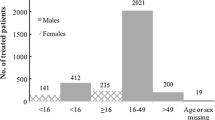Abstract
Background
Combat-wounded service members are surviving battle injuries more than ever. Given different combat roles held by men and women, female service members should survive wounds at an unprecedented rate.
Questions/purposes
We determined whether the casualty rates for females differ from their male counterparts and characterized wounds sustained by female casualties.
Methods
We calculated the percentage of the 5141 deaths among the 40,531 casualties by gender for those serving in Operations Enduring Freedom (OEF) and Iraqi Freedom (OIF) from Defense Manpower Statistics between 2001 and 2009. We searched the Joint Theatre Trauma Registry for female casualties and described their injury characteristics. No matched cohort of male casualties was searched.
Results
Female veterans comprised 1.9% of all casualties and 2.4% of all deaths. In OIF, the percent death for women was 14.5% (103 deaths) versus 12.0% (4226 deaths) for men. In OEF, the percent death for women was 35.9% (19 deaths) versus 17.0% (793 deaths) for men. Battle-injured females had a greater proportion of facial and external injuries and more severe extremity injuries compared with those nonbattle-injured.
Conclusions
The casualty death rate appears higher for women than men although the mechanisms of fatal injuries are not known and may not be comparable. Although facial, external, and extremity injuries were common among battle-injured females, no conclusion can be made as to whether male casualties sustain similar wounding patterns.
Level of Evidence
Level II, prognostic study. See Guidelines for Authors for a complete description of levels of evidence.

Similar content being viewed by others
References
Army Regulation 600-13. Army Policy for the Assignment of Female Soldiers. Available at: http://armypubs.army.mil/epubs/pdf/r600_13.pdf. Accessed November 16, 2010.
Belmont PJ, Goodman GP, Zacchilli M, Posner M, Evans C, Owens BD. Incidence and epidemiology of combat injuries sustained during ‘the surge’ portion of Operation Iraqi Freedom by a US Army brigade combat team. J Trauma. 2010;68:204–210.
Centers for Disease Control and Prevention. 2006 United States All Injury Deaths and Rates per 100,000. Available at: http://webappa.cdc.gov/cgi-bin/broker.exe. Accessed February 2010.
Defense Manpower Data Center—Data, Analysis, and Programs Division. Global War on Terrorism: Casualties by Military Service Component—Active, Guard and Reserve. Available at: http://siadapp.dmdc.osd.mil/personnel/CASUALTY/OCO_component.pdf. Accessed May 2009, December 2010.
Ficke J, Pollack A. Extremity war injuries: development of clinical treatment principles. J Am Acad Orthop Surg. 2007;15:590–595.
Frink M, Pape HC, van Griensven M, Krettek C, Chaudry IH, Hildebrand F. Influence of sex and age on MODS and cytokines after multiple injuries. Shock. 2007;27:151–156.
George RL, McGwin G, Windham ST, Melton SM, Metzger J, Chaudry IH, Rue LW. Age-related gender differential in outcome after blunt or penetrating trauma. Shock. 2003;19:28–32.
Haider AH, Crompton JG, Oyetunji T, Stevens KA, Efron DT, Kieninger AN, Chag DC, Cornwell EE, Haut ER. Females have fewer complications and lower mortality following trauma than similarly injured males: a risk adjusted analysis of adults in the National Trauma Data Bank. Surgery. 2003;146:308–315.
Hess J, Holcomb J. Transfusion practice in military trauma. Transfusion Medicine. 2008;18:143–150.
Holcomb J. The 2004 Fitts Lecture: current perspectives on combat casualty care. J Trauma. 2005;59:990–1002.
Holcomb J, Caruso J, McMullin N, Wade CE, Pearse L, Oetien-Gerdes L, Champion HR, Lawnick M, Farr W, Rodriguez S, Butler F. Causes of death in US Special Operations Forces in the global war on terrorism: 2001–2004. US Army Med Dep J. 2007;Jan–Mar:24–37.
Holcomb JB, Stansbury LG, Champion HR, Wade C, Bellamy RF. Understanding combat casualty care statistics. J Trauma. 2006;60:397–401.
Kauvar DS, Cancio LC, Wolf SE, Wade CE, Holcomb JB. Comparison of combat and non-combat burns from ongoing US military operations. J Surg Res. 2005;15:195–200.
Kragh JF Jr. Use of tourniquets and their effects on limb function in the modern combat environment. Foot Ankle Clin. 2010;15:23–40.
Owens B, Kragh J, Macaitis J, Svoboda S, Wenke J. Characterization of extremity wounds in Operation Iraqi Freedom and Operation Enduring Freedom. J Orthop Trauma. 2007;21:254–257.
Ramasamy A, Harrisson SE, Clasper JC, Stewart MP. Injuries from roadside improvised explosive devices. J Trauma. 2008;65:910–914.
Stansbury L, Lalliss S, Branstetter J, Bagg M, Holcomb J. Amputations in US military personnel in the current conflicts in Afghanistan and Iraq. J Orthop Trauma. 2008;22:43–46.
Street AE, Vogt D, Dutra L. A new generation of women veterans: stressors faced by women deployed to Iraq and Afghanistan. Clin Psych Rev. 2009;29:685–694.
US Department of Veterans Affairs, Office of Public Health and Enviornmental Hazards. Women Veterans Health Care: Women Veterans of Operations Enduring and Iraqi Freedom. Available at: www.publichealth.va.gov/womenshealth/facts.asp. Accessed November 18, 2010.
Acknowledgments
We acknowledge the Joint Theater Trauma Registry (JTTR) for providing data for this study.
Author information
Authors and Affiliations
Corresponding author
Additional information
Each author certifies that he or she has no commercial associations (eg, consultancies, stock ownership, equity interest, patent/licensing arrangements, etc) that might pose a conflict of interest in connection with the submitted article.
Each author certifies that his or her institution has approved the reporting of these cases, that all investigations were conducted in conformity with ethical principles of research, and that informed consent for participating in the study was obtained.
The opinions or assertions contained herein are the private views of the authors and are not to be construed as official or as reflecting the views of the Department of the Army or the Department of Defense.
This study was performed at Brooke Army Medical Center and the Institute of Surgical Research.
About this article
Cite this article
Cross, J.D., Johnson, A.E., Wenke, J.C. et al. Mortality in Female War Veterans of Operations Enduring Freedom and Iraqi Freedom. Clin Orthop Relat Res 469, 1956–1961 (2011). https://doi.org/10.1007/s11999-011-1840-z
Published:
Issue Date:
DOI: https://doi.org/10.1007/s11999-011-1840-z




